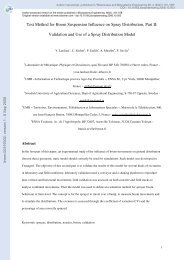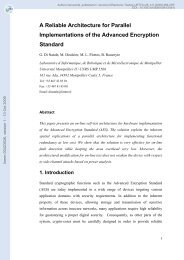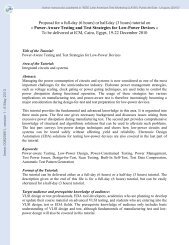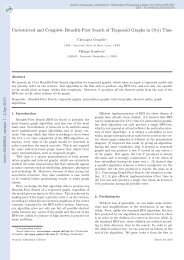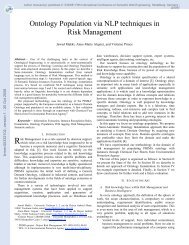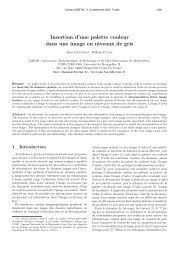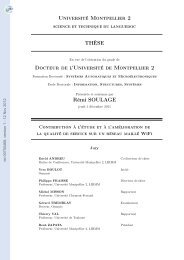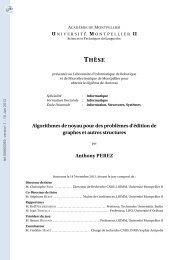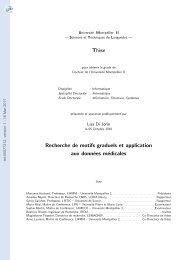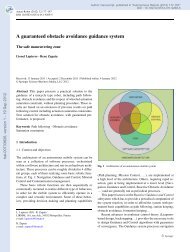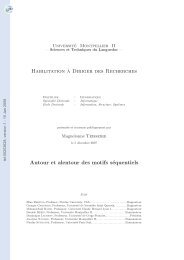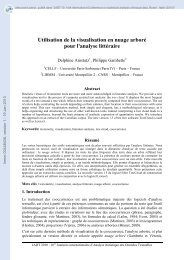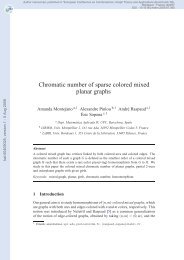FMA & HMTP Portal in OWL - HAL - LIRMM - CNRS
FMA & HMTP Portal in OWL - HAL - LIRMM - CNRS
FMA & HMTP Portal in OWL - HAL - LIRMM - CNRS
You also want an ePaper? Increase the reach of your titles
YUMPU automatically turns print PDFs into web optimized ePapers that Google loves.
cerebral artery etc. The second mode is a stemm<strong>in</strong>g search that uses roots of words,<br />
remov<strong>in</strong>g usual prefixes and suffixes, e.g., search<strong>in</strong>g for ‘cérébelleuses’ without<br />
stemm<strong>in</strong>g provides 8 answers, while with stemm<strong>in</strong>g 43, as they <strong>in</strong>clude terms like<br />
‘cerebelleux’. The last mode is an exact search that looks for the exact expression<br />
entered, e.g.; ‘Myocardial <strong>in</strong>farction’.<br />
(b) It is possible to browse all term<strong>in</strong>ologies. In particular, the 'Relations' l<strong>in</strong>k<br />
offers a critical means for a user to navigate with<strong>in</strong> and between term<strong>in</strong>ologies, and<br />
thus to discover new <strong>in</strong>formation about relations between concepts. Intra-term<strong>in</strong>ology<br />
relations state associations between concepts with<strong>in</strong> a given ontology, while Interterm<strong>in</strong>ology<br />
relations state associations between concepts of different term<strong>in</strong>ologies.<br />
The later rely on mapp<strong>in</strong>gs that are manually <strong>in</strong>serted by professionals or obta<strong>in</strong>ed<br />
either from the UMLS or by specific techniques of natural language.<br />
(c) When a term belongs to a hierarchy, the Hierarchy Tab is displayed, which<br />
enables to visualize the term position <strong>in</strong> the (multi-)hierarchy<br />
(d) Additional Tabs allow to search for a term <strong>in</strong> Pubmed, Doc'CISMeF, or<br />
InfoRoute (French Infobutton [11]).<br />
User profiles enable to give a restricted access to <strong>HMTP</strong> among specific<br />
term<strong>in</strong>ologies. <strong>HMTP</strong> relies on dedicated Web Service that send a SKOS answer to<br />
the server. <strong>HMTP</strong> is a Graphic User Interface that displays the data result<strong>in</strong>g from the<br />
selection or search operated by the Web Services.<br />
3.2 <strong>HMTP</strong> representation<br />
<strong>HMTP</strong> key-stone is the ‘Unify<strong>in</strong>g Model of Vocabulary’ (UMV2). Its pr<strong>in</strong>ciples are<br />
<strong>in</strong>spired by RDF and UML reification.<br />
Unify<strong>in</strong>g Model of Vocabulary. UMV2 is a common model for all terms,<br />
whatever their term<strong>in</strong>ology. It can be viewed as a meta-model or an upper ontology<br />
designed to support broad semantic <strong>in</strong>teroperability between a large number of<br />
term<strong>in</strong>ologies accessible under it. The basic concept of UMV2 is Descriptor,<br />
which is quite similar to skos:Concept. Descriptor has several attributes, e.g.;<br />
label refers to the preferred term used to name a descriptor <strong>in</strong> natural language,<br />
synonym refers to its synonyms <strong>in</strong> different languages, notation to its identifier.<br />
Another key concept is Association, used to model a relation between two<br />
descriptors as a class. It is quite similar to UML association classes. The concept<br />
Group, close to UML aggregation, is used to model a set of descriptors, for <strong>in</strong>stance<br />
a term<strong>in</strong>ology, e.g.; ICD10 or a group of term<strong>in</strong>ologies, e.g.; SMQ, Standardised<br />
MedDRA Queries). In turn, the components and sub-components of ICD10, Chapter,<br />
Category, etc. are modeled as groups. For example, Chapter XI that list all the<br />
“Diseases of the digestive system”, further divided <strong>in</strong>to the categories from K00 to<br />
K93 (K00-K93), are all modeled as groups. UMV2 <strong>in</strong>cludes other general classes<br />
such as BT-NT for a hierarchical association, or RT-RT for “See Also” associations.<br />
UMV2 offers general properties that can be used to relate the <strong>HMTP</strong> descriptors. For<br />
<strong>in</strong>stance, the properties BT and NT of a BT-NT asssociation are used to assert that the<br />
two descriptors respectively referred by BT and NT have a hierarchical l<strong>in</strong>k. BT states<br />
the more general term of an association (‘broader’) and NT the more specific<br />
11



